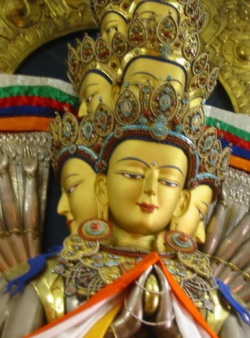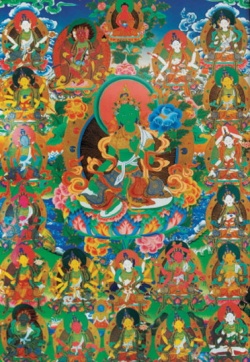Symbolism of Animals in Buddhism
Symbolism of Animals in Buddhism
Ven. Jampa Choskyi
Buddhist Himalaya, VOL. I NO. I
SUMMER 1988
Copyright 1988 by Gakken Co. Ltd.
In Asian culture there is aot such a wide gap between Spiritual and material things as there seems to exist in the western civilization of today. Therefore religious symbols are a living part of all aspects of Asian culture.
We will describe the different symbols both in their outer and inner or esoteric meaning, according to the different teachings of Lord Budddha. However, according to the bnuddhisst teachings the very physical existence of any Phenomena is dependent on the inner meaning, which is due to the Mental creation or Karmic activity of the Sentient beings. That means that the face that the symbols do exist is due to the Mental or Karmic creation of those beings and cannot exist without it. Just as a plant needs a seed in order to come into existence, in the same way the plant as a Symbol exists only because there is a Karmic seed which causes it. In fact, the very existence of the material or physical plant is also dependent on the existence of a karmic seed in the Consciousness of the beings in whose World that plant grows Therefore what we call symbols are not artificial, cultural creations invented by somebody, but they correspond to a real karmic activity which manifests in the external level as a material object-a plant or animal in this case-and in the internal, Mental level corresponds to a Mental experience. The actual reality of these symbols has been experienced directly in Meditation by those highly realized beings like Sakyamuni Buddha and others. They somehow discovered the real nature of the symbols through their pure vision and understanding Even ordinary beings can perceive to some extent the real nature of symbols, but in order to get a clearer understanding some Intellectual explanations are needed.
Generally the buddhist as well as other religious symbols, are considered as a cultural item, without understanding at all their real significance. They are used or venerated only because it is the tradition of one's own country to do so, or because it is believed that these symbols or objects bring good luck and prosperity. In fact these symbols not only can bring good luck, long Life and prosperity but can also bring the highest realization of the real nature of all existences. They can help Sentient beings to develop their own inner Wisdom and attain the level of a Buddha, no matter what other name they want to give to it. And that is why symbols do exist as manifestations of this Wisdom inherent in all Sentient beings 'Mind. In its present essay only five Animals have been described briefly.
THE LION
Lions are the kings of the animal kingdom: they are proud and majestic. They live in the plains and grassy hills, never in the mountains and sur4ely not in the high snow mountains. Lions are organised into clans or groups and never live alone except in the case of old lions or those who are expelled from the community. They get their Food by Hunting which is always done by the females and never by the males. The male's job is to protect the clan from enemies. However, lions do not have any natural enemy. Due to these caracteristics the lion has been considered through all ages and countries as a Symbol of royaity and protection, as well as of Wisdom and pride. The iconographic representation of the lion originated in Persia.
In Buddhism lions are symbolic of the bodhisattvas, the "sons of The Buddha" or "Buddha's lions". bodhisattvas are beings who have attained a high level of Spiritual development. They have generated Bodhicitta and made the vow to renounce the Happiness of the highest Enlightenment and remain in this World working until all Sentient beings are free from Suffering. bodhisattvas practise the six basic paramitas: Charity. Morality, Patience. effort, Concentration and Wisdom [[[dana]], sila, ksanti, verya, dhyana and prajna] and the four which derive from the basis ones: skillfull means, vows, Power and Knowledge [[[upaya]], pranidhana, bala and jnana]. Tehre are eight great or divine bodhisattvas. In the Nispannygavaqli of Mahapandita Abhayakara Gupta three sets of sixteen bodhisattvas are mentioned.
In buddhist iconography we find the lions in their role of Dharma Protectors supporting the throne of the Buddhas and bodhisattvas. They are also found at the entrance of the Monasteries and shrines. In the northern areas of Nepal, influenced by Tibetan Buddhism and Art, the lions have become "snow lions". Actually there are no lions living in the snow mountains, but there are leopards. Snow lions area depicted in white or blue colour with turquoise or orange mane floating in the wind and very wrathful, with big eyes and open mouth. They roam freely in the high snow mountains without any fear, symbolizing the Wisdom, fearlessness and divine pride of those Dharma practitioners who are actually able to live freely in the high snow mountain of the pure Mind, without being contaminated by delusions. They are kings of the Doctrine because they have achieved the Power to subdue all beings with their great Love, Compassion and Wisdom.
The lions as guardians of the temple are represented in pairs at the entrance of shrines and baha compounds.
Elephants
The main characteristics of the elephant are his strength and steadfastness. There for it become a Symbol of physical and Mental strength, as well as responsibility and earthiness.
In Indian mythology we hear about the flying Elephants and Airavata, the white elephant who become the vehicle of Indra and appeared from the churning of the milky ocean. Therefore white Elephants are considered very special and with the Power to produce rain. They are identified as rain-bearing clouds, which will explain the belief in the flying Elephants. In Indian society Elephants were considered to bring good luck and prosperity. They were owned by the kings and used in wars.
In Buddhism the elephant is a Symbol of Mental strength. At the beginning of one's practice the uncontrolled Mind is symbolised by a gray elephant who can run wild any moment and destroy everything on his way. After practicing Dharma and taming one's Mind, the Mind which is now brought under control is symbolised by a white elephant strong and powerful, who can be directed wherever one wishes and destroy all the obstacles on his way.
Buddha Shakyamuni was born as elephant in some of his previous incarnations. Also in his last incarnation as Siddharth Gautama he songs: descended from the Tushita Pure land and entered his mother's womb in the Form of a white elephant.
In buddhist iconography we find the elephant-faced deity Gangpati or Ganesh as an emanation of the Bodhisattva Avalokitesvara. Also in another aspect, representing the worldly aspect of the same evergy he is trampled upon by same other deities such as Mahakala, Vajra Bhairava and others.
In the Mandala Offering Ritual one offers to The Buddha the Precious Elephant, with the strength of one thousand Elephants and who can circumdbulate the whole Universe three times in one day. Also the elephant tusks are one of the Seven Royal Emblems.
The elephant is the vehicle of the Tathagata Aksobhya and the deity Balabadra. The elephant also appears as a guardian of the temples and of Buddha himself.
THE HORSE
Horses have always been the means of transport. They can run very fast and it is that in previous times they had wings and could fly. Even in Greek mythology we have Pegasus, the flying horse. Their main Characteristies is their loyalty, industriousness and swiftness. A good example of these qualities is Kantaka, the horse of Siddhartha Gautama. When the future Buddha lift his palace in order to become an ascetic, his horse realised that he will never see his mas6ter again and died of a broken greart. He was reborn in one of the heavens.
In Buddhism the horse is symbolic of energy and effort in the practice of Dharma. It also symbolizes the air or prana which runs through the channels of the Body and is the vehicle of the Mind.
In that sense we can quote a passage from one of Milarepa's "Song of the galloping horse of a yogi."
- "In the mountain hermitage which is my Body,
- In temple of my breast
- At the summit of the triangle of my Heart,
- The horse which is my Mind flies like the wind"
- "He gallops on the plains of great bliss.
- If he persists, he will attain the rank of a victorious Buddha.
- Going backward, he cuts the root of Samsara.
- Going forward he reaches the high land of Buddhahood.
- Astride such a horse, one attains the highest illumination"
- [translated by Losang P. Lhalungpa]
The so called "Wind-Horse" symbolic of the Mind the Mind its vehicle the wind, can be ridden upon. That means that we have the possibility of controlling the Mind and wind and guide it towards any direction and at any speed that we wish.
The neigh of a horse is also symbolic of the Power of The Buddha to awaken the sleepy Mind for the practice of Dharma.
There are some stories of the Bodhisattva Lokesvara taking the shape of a horse in order to help Sentient beings.
In buddhist iconography the horse support the throne of the Tathagatha Ratnasambhava and carries the chariot of Surya, the sun God. The horse is also the vehicle of many other deities and Dharma Protectors, such as Mahali, and there are horse-faced deities, such as Hayagriva.
THE PEACOCK
In a general sense peacocks are a Symbol of openness and acceptance. In Christianity the peacock is a Symbol of immortality. In Mesopotamia appeared a symbolic representation of a tree flanked by two peacocks, which is said to symbolise the dualistic Mind and the absolute unity. In Hinduism the patterns of the peacocks feathers, resembling eyes, symbolise and stars. In Buddhism they symbolise Wisdom.
Peacocks are said to have the ability of eating poisonous plants without being affected by them. Because of that, they are synonymous with the great bodhisattvas. A Bodhisattva is able to take delusions as the path toward Liberation and transform the poisonous Mind of Ignorance, desire and hatred [[[moha]], raga, dvesa] into the Thought of Enlightenment or Bodhicitta, which opens colourfully like the peacocks' tail.
Here we will quote from a teaching called "The wheel of sharp weapons", written by Dharmaraksita, who passed it to his main Disciple Dipankara Sri Jnana [[[Atisa]], 982-1054].
- "In jungles of poisonous plants strut the peacocks,
- Through medicine Gardens of Beauty lie near.
- The masses of peacocks do not find Gardens pleasant,
- But thrive on the essence of poisonous plants,
- In similar fashion the brave bodhisattvas
- Remain in the jungle of worlds concern.
- No matter how joyful this World pleasure garden,
- These brave ones are never attracted to pleasures,
- But thrive in the jungle of Suffering and pain."
The Mind of the Sentient beings in this World is like a thick forest of desire and hatred. The pleasures and material possessions are like a beautiful medicinal garden. The brave-minded bodhisattvas, because of having realised the shortcomings of Samsara, are not atracted to samsaric pleasures, just as the peacocks are not attracted to medicinal plants. The bodhisattvas, having the attitude of wishing only to work for Sentient beings and not desiring any Happiness for themselves, can utilise the poisonous thoughts of Ignorance, desire, hatred and so forth in order to accomplish the works for Sentient beings.
Bu eating poison, the peacocks' Body becomes healthy and beautiful. He is adorned with five feathers on the head, which symbolise the Five Paths of the boddhisattva and the attainment of the Five Buddha Families. They have beautiful colours, like blue, red, green and please other beings just by being seen. Similarly, any Body who sees a Bodhisattva receives great Happiness in his Mind. The peacock's eating habits of eating poisonous plants do not cause harm to other beings. Similarly the bodhisattvas don not give the slightest harm to any other Sentient beings. By eating poison the colours of his feathers become bright and his Body healthy. Similarly, by taking all problems and Suffering upon themselves, the bodhisattvas quickly purify the Mental obscurations and develop their Mind quickly, attaining higher and higher realization. Particularly peacocks symbolise the transmutting of desire into the path of Liberation. Therefor they are the vehicle of Buddha Amitabha, who represents desire and Attachment transmuted into the Wisdom of Discriminating Awareness.
GARUDA
Garuda is the king of bgirds. Its name derives from the root Gri, to swallow: garuda devours the snakes. He is represented with a human upper Body, big eyes, beak, short blue horns, yellow Hair standing on end, bird's claws and wings. However, sometimes, mainly in Hindu iconography, he is represented in human Form with wings.
Garuda is a very big bird and comes out of the egg fully grown. Garuda symbolizes the space element and the Power of the sun, which can dry up the waters. Therefore he is the natural enemy of snakes and he devours or controls them. He represents the Spiritual energy of which devours the delusions of jealousy. And hatred, which are represented by the snake. Garuda is also the openness: he can stretch out his wings and soar into space. He represents the great freedom of the Mind which can open and is not uptied by confliction emotions the wise Mind which reaches every where, like the rays of the sun, and brings about the growth of Life and Wisdom. Specifically in Buddhism Garuda is related of the perfection of gibing [[[dana]] paramita], just as the rays of the sun give Life to the earth.
The myth of the great bird devouring the snake seems to have originated in Mesopotamia. The snake represents the subconscious or hidden aspects of the Mind, those feelings and thoughts which crawl underneath the surface. Garuda can perceive any tiny snake and instantly fall upon in. Similarly, by practicing awareness of all our feelings, thoughts and actions we can develop the Wisdom which can perceive perfectly the workings of our Mind and in that way we can achieve complete freedom to act utilizing out Mind in the most beneficial way.
In Hindu Iconography Garuda is the vehicle of Vishnu. In Buddhism, he is the vehicle of Amoghasiddhi, The Buddha who embodies the all accomplishing Wisdom. He is also the vehicle of a from of Lokishvara Hariharihar vahana. garuda is also a deity of his own who is supposed to cure snakebite, epilepsy and diseases caused by Nagas. An image of Garuda is found in the toranas, the semicircular tympanum above the temple doors.
The emerald, also called Garuda stone is considered a protection against poison and Garuda images appear in Jewellery as a protection against snake bite.





